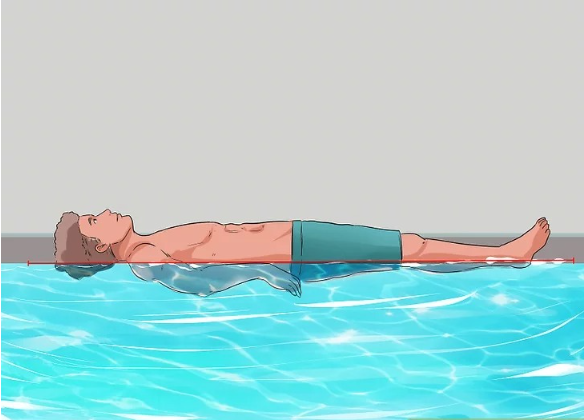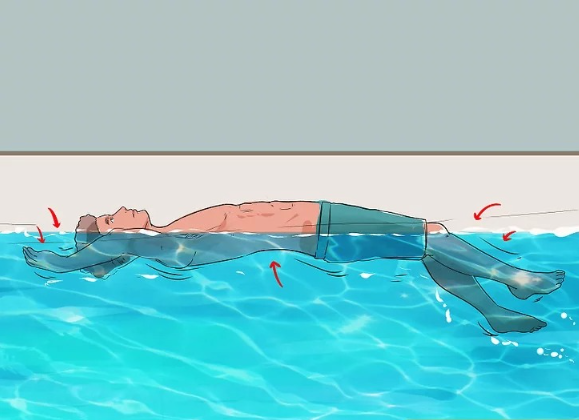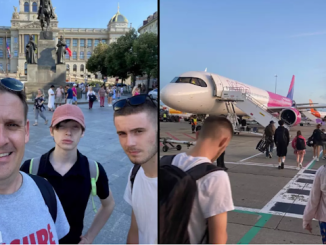Falling into deep water unexpectedly can be a terrifying experience, especially if you don’t know how to swim. Panic sets in, your instincts tell you to struggle, and before you know it, you’re exhausted and in real danger. However, survival in such a situation is entirely possible if you remain calm and follow a set of simple but life-saving steps.
According to Dr. Nash and his team of researchers, the key to survival is overcoming fear instincts and following five crucial steps. These steps are designed to help anyone—regardless of swimming ability—stay afloat, breathe, and increase their chances of rescue. Let’s dive into these life-saving techniques.
1. Stay Calm and Relax to Achieve Natural Buoyancy

The first and most critical step is to fight the urge to struggle. Many people instinctively flail their arms and legs in a desperate attempt to stay above water. However, this only wastes energy and causes faster exhaustion.
Instead, take a deep breath and allow your body to relax. When you stop panicking, your body will naturally float closer to the water’s surface. The human body is slightly less dense than water, meaning that if you remain still, you can achieve buoyancy without much effort.
2. Tilt Your Head Back to Keep Your Airway Clear
Once you’ve calmed yourself and started floating, you need to ensure that you can breathe. The best way to do this is to tilt your head back, keeping your face above the water.
Try not to move too much, as sudden movements can make you sink slightly. If you feel yourself going under, resist the urge to panic—simply take a deep breath, relax your muscles, and allow yourself to rise again.
Video : How to Survive if You Fall in Water – Prevent Yourself From Drowning – Survival Techniques
3. Breathe Slowly and Avoid Inhaling Water
Now that your nose and mouth are above water, it’s time to focus on breathing. Many people instinctively gasp for air, but this can lead to choking if water splashes into your mouth. Instead, practice controlled breathing:
- Exhale slowly through your nose to clear any water that may have entered.
- Inhale through your mouth in a controlled manner.
- If a wave covers your face, hold your breath momentarily, then resume normal breathing.
Even experienced swimmers can struggle if they inhale water, so maintaining steady breathing is crucial for survival.
4. Move Your Arms and Legs Gently to Stay Afloat
At this point, you should be floating on the water’s surface and breathing steadily. The next step is to use gentle, controlled movements to maintain your position.
- Use slow arm movements: Move your arms in a sweeping motion, like you’re making small circles in the water. This will help you stay afloat without expending too much energy.
- Legs should remain still if you don’t know how to kick properly: If you’re unsure how to tread water, keeping your legs still is often better than kicking randomly. Let them sink slightly while focusing on keeping your upper body above water.
The key here is to avoid frantic movements—slow and deliberate strokes will keep you afloat much longer.

5. Look for Rescue Opportunities
Once you’ve gained control of your breathing and movements, your next priority is finding a way to safety.
- Scan your surroundings – Look for anything floating that you can grab onto, such as a buoy, a log, or even a piece of debris. Holding onto something will help you conserve energy.
- Check your distance from the shore – If you can see land, assess whether it’s possible to move toward it using slow, steady movements.
- Signal for help – If there are people nearby, shout for help. However, conserve energy by calling out only when necessary.
If you’re caught in a strong current, do not try to swim directly against it—this will only tire you out. Instead, swim diagonally at an angle to gradually move out of the current’s pull.
What to Do If You See Someone Drowning
If you witness someone struggling in deep water, it’s important to act quickly but safely. Jumping in to rescue them may seem like the right thing to do, but unless you’re a trained rescuer, it could put both of you at risk.
Instead, follow these steps:
- Shout instructions – Encourage the person to follow the survival steps above. Remind them to relax, tilt their head back, and float.
- Find a flotation device – If possible, throw a life jacket, a rope, or any floating object they can grab onto.
- Call emergency services – Immediately contact your local emergency number and provide details of the situation.
Video : How to get over fear of water – Feel safe on the deep end
Why Staying Calm is the Key to Survival
Many drowning incidents occur not because the victim physically sinks, but because they panic and exhaust themselves. Learning how to override panic instincts and follow a survival routine can mean the difference between life and death.
Dr. Nash explains:
“Whether you’re planning a vacation, taking a walk near a river, or going for a swim, knowing how to stay safe in water is crucial. These simple survival techniques can save your life or someone else’s.”
Final Thoughts
Surviving a fall into deep water without knowing how to swim is possible—but only if you remain calm and follow the right steps. By floating, maintaining steady breathing, and making slow movements, you can conserve energy and increase your chances of rescue.
Now that you know these survival strategies, share them with your friends and family. You never know when this knowledge might save a life!
I COMPLAINED ABOUT MY NEW NEIGHBORS’ HORRIBLE FOUNTAIN & RECEIVED A THREATENING NOTE FROM THEM.

The quietude of Elm Street, once a symphony of birdsong and gentle laughter, had been shattered. The arrival of the new neighbors, the Morlocks, had thrown the idyllic tranquility of their little community into chaos.
Initially, I had tried to be welcoming. A plate of freshly baked cookies, a warm smile, a friendly “Welcome to the neighborhood!” But my overture had been met with a chilling silence. The woman who answered the door, pale and gaunt, had regarded me with a suspicion that bordered on paranoia. “Ew, it smells awful,” she had muttered, her eyes darting nervously around as if I were some sort of disease.
Then came the fountain. A monstrosity of wrought iron and gargoyles, it stood imposingly in their yard, a constant, jarring presence. The incessant gurgling and splashing, day and night, had become the soundtrack to our lives. Sleep became elusive, replaced by the monotonous drone of the water.
The neighborhood, once a haven of peace and camaraderie, was now a battleground. Tempers flared. Arguments erupted at the weekly community meetings. Finally, a vote was taken – a unanimous decision to request the removal of the fountain.
And so, the unenviable task of filing the official complaint fell to me. I, the self-proclaimed peacemaker, the neighborhood’s unofficial ambassador of goodwill, was now the bearer of bad tidings.
That evening, as I returned home, a small, ominous package lay on my doorstep. No return address. A shiver ran down my spine.
Inside, a single sheet of paper, scrawled with menacing handwriting:
“I KNOW YOUR SECRET. YOU WILL BE POLITE TO YOUR NEW NEIGHBORS, OR EVERYONE WILL KNOW.”
Fear, cold and clammy, gripped me. Who was it? The Morlocks? Or someone else, someone watching, someone waiting for the right moment to strike?
The following days were a blur of paranoia and unease. I checked every window and door lock multiple times a night. I slept with the light on, the faintest sound sending shivers down my spine. My once peaceful neighborhood had transformed into a place of fear and suspicion.
The police, after much persuasion, agreed to investigate. They questioned the Morlocks, of course, but they denied any involvement. The woman, her face gaunt and drawn, maintained her innocence, claiming she was simply trying to enjoy her own property.
The investigation yielded nothing. No fingerprints, no witnesses, no concrete evidence. The threat remained, a chilling reminder of the darkness that lurked beneath the surface of our seemingly idyllic community.
I started carrying a small can of pepper spray, my hand instinctively reaching for it at every rustle of leaves, every unfamiliar sound. I avoided going out alone at night, my days filled with a constant sense of unease.
The incident had changed me. The once friendly, outgoing neighbor was now withdrawn, suspicious, constantly scanning the shadows for signs of danger. The peace and tranquility of Elm Street, shattered by the arrival of the Morlocks, had been replaced by a chilling sense of fear and uncertainty.
And the fountain, that monstrous, discordant symbol of their arrival, continued to spew its icy water, a constant reminder of the darkness that had seeped into the heart of their once idyllic community.I COMPLAINED ABOUT MY NEW NEIGHBORS’ HORRIBLE FOUNTAIN & RECEIVED A THREATENING NOTE FROM THEM.



Leave a Reply